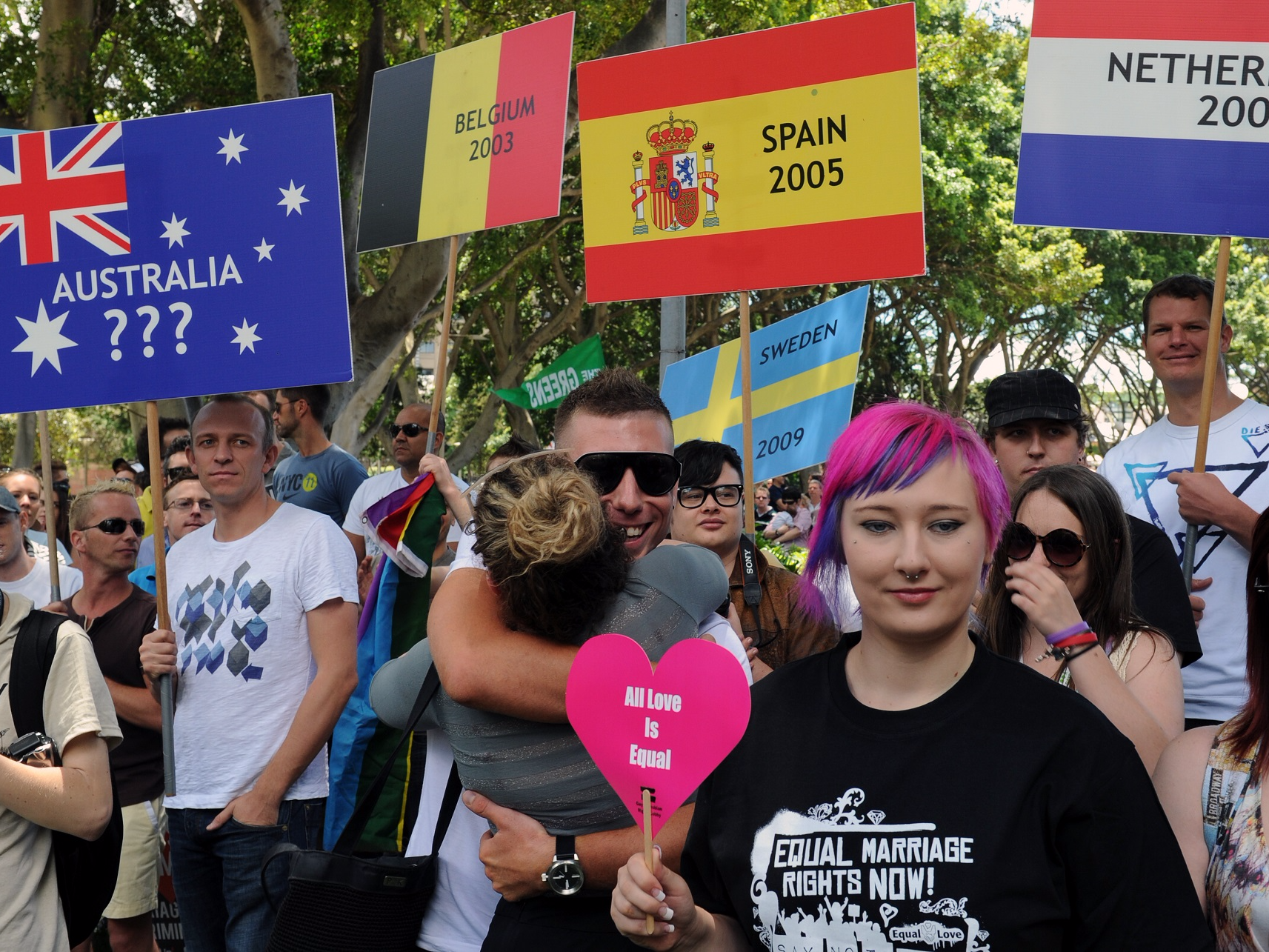This week, Australians overwhelmingly voted in favor of changing the law to allow same-sex marriage.
Despite Australia’s role as host of one of the world’s largest LGBTQI pride parades, Sydney’s Gay and Lesbian Mardis Gras, it has lagged behind other Western countries on LGBTQI rights, including same-sex marriage.
While campaigning for LGBTQI rights has been an uphill battle in Australia and also the US, in 2015 same-sex marriage was legalized by the US Supreme Court in a landmark 5-4 decision.
And now, more than two years later, Australia’s federal government has pledged to pass legislation before the end of 2017.
Here's how Australia's march toward legalizing same-sex marriage compares to the US:
The US began moving toward legalizing same-sex marriage in the 1970s, when the first lawsuits seeking legal recognition of same-sex relationships first emerged.

These lawsuits pushed the idea of legally recognizing same-sex relationships into the public and started the discussions on same-sex marriage.
Source: The New York Times
A 1993 lawsuit in Hawaii evoked the US Constitution to argue against a same-sex marriage ban.

In 1993, a lawsuit in Hawaii claimed that banning same-sex marriage violated the state's constitution. The case, which made it to the US Supreme Court but was dismissed in 1999, set the tone for discussions on same-sex marriage in the new millennium.
Source: University of California, Berkeley
As the movement gained steam, the Defense of Marriage Act (DOMA) was enacted in 1996.

DOMA federally defined marriage as a union between a man and a woman, however the bill did not prevent individual states from recognizing same-sex marriages.
Source: GovTrack
In 2003, Massachusetts was the first US state to legalize same-sex marriage.

Between 2003 and 2015, state-level decisions legalized same-sex marriage in 38 out of 50 US states and increased momentum towards federal legalization.
Source: Georgetown Law Library
In 2013, the Supreme Court overturned a key provision of DOMA.

The Supreme Court decided Section 3 of DOMA, that had defined marriage as a "legal union between one man and one woman," was unconstitutional because it singled out a "class of persons" for discrimination.
Source: Business Insider
In 2015, after many years of progress, the US Supreme Court ruled in favor of same-sex marriage.

Justice Anthony Kennedy issued the 5-4 ruling that found the Fourteenth Amendment - which guarantees "equal protection under the law" - requires states to license same-sex marriages.
Source: Business Insider
The Marriage Act in 1961, which is still in place, was created to regulate marriage law in Australia.

It requires marriage celebrants at weddings to explain the legal nature of a marriage as "a union of a man and a woman to the exclusion of all others."
Source: Australian Government
Before the 1970s, Australia had strict laws prohibiting homosexual activity.

But between 1975 and 1997, Australian states repealed laws prohibiting same-sex relationships and support for LGBTQI rights began to flourish.
Source: University of Minnesota Human Rights Library
In 2003, states and territories began granting domestic-partnership benefits to same-sex couples, including rights for guardianship, adoption, and the ability to have legally recognized "same-sex unions."

This marked a huge turning point for LGBTQI rights in Australia, and recognized same-sex couples under the law. But since 2004, 22 bills have been introduced to deal with same-sex marriage, and all four that came to a vote were defeated.
Source: Parliament of Australia
In 2013, the Australian Capital Territory (ACT) legalized same-sex marriage territory-wide.

This was the first time a state defied federal law regarding same-sex marriage. However the Australian High Court ruled the law was unconstitutional less than a week later and marriages held under the statute were annulled.
Source: ABC News (Australia)
In 2017, the Australian government announced it would organize a national vote on same-sex marriage.

The vote, which was a non-compulsory, non-binding postal survey, simply asked: "Should the law be changed to allow same-sex couples to marry?"
Source: Business Insider Australia
61.6% of Australians voted 'yes.'

While the survey was not mandatory, nearly 80% of eligible Australian voters mailed in their votes. A vast majority, roughly 61.6% of Australians surveyed, voted in favor of same-sex marriage.
While the public's resounding 'yes' vote isn't legally binding, the government is set to bring forth legislation this week that will begin steps to federally allow same-sex marriage.
Source: Business Insider Australia

